TESCO Performance Improvement: Applied Research Report, Diploma
VerifiedAdded on 2023/01/11
|23
|5165
|32
Report
AI Summary
This report, prepared for a Graduate Diploma of Management, delves into applied research methodologies, data collection, and analysis techniques. Section 1 explores communication processes, effective communication methods (face-to-face, written, non-verbal), and data collection techniques (observation, interviews, questionnaires, literature review, focus groups). It highlights the role of technology in data collection and analysis, and outlines legal requirements, policies, and guidelines for applied research. The report details methods for presenting research findings, including tables, graphs, and diagrams. Section 2 focuses on applying research to improve TESCO's organizational performance, including constructing a research strategy, gathering and analyzing data, and ensuring data integrity and accuracy. The report concludes with a summary of findings and recommendations, offering practical insights for organizational improvement.
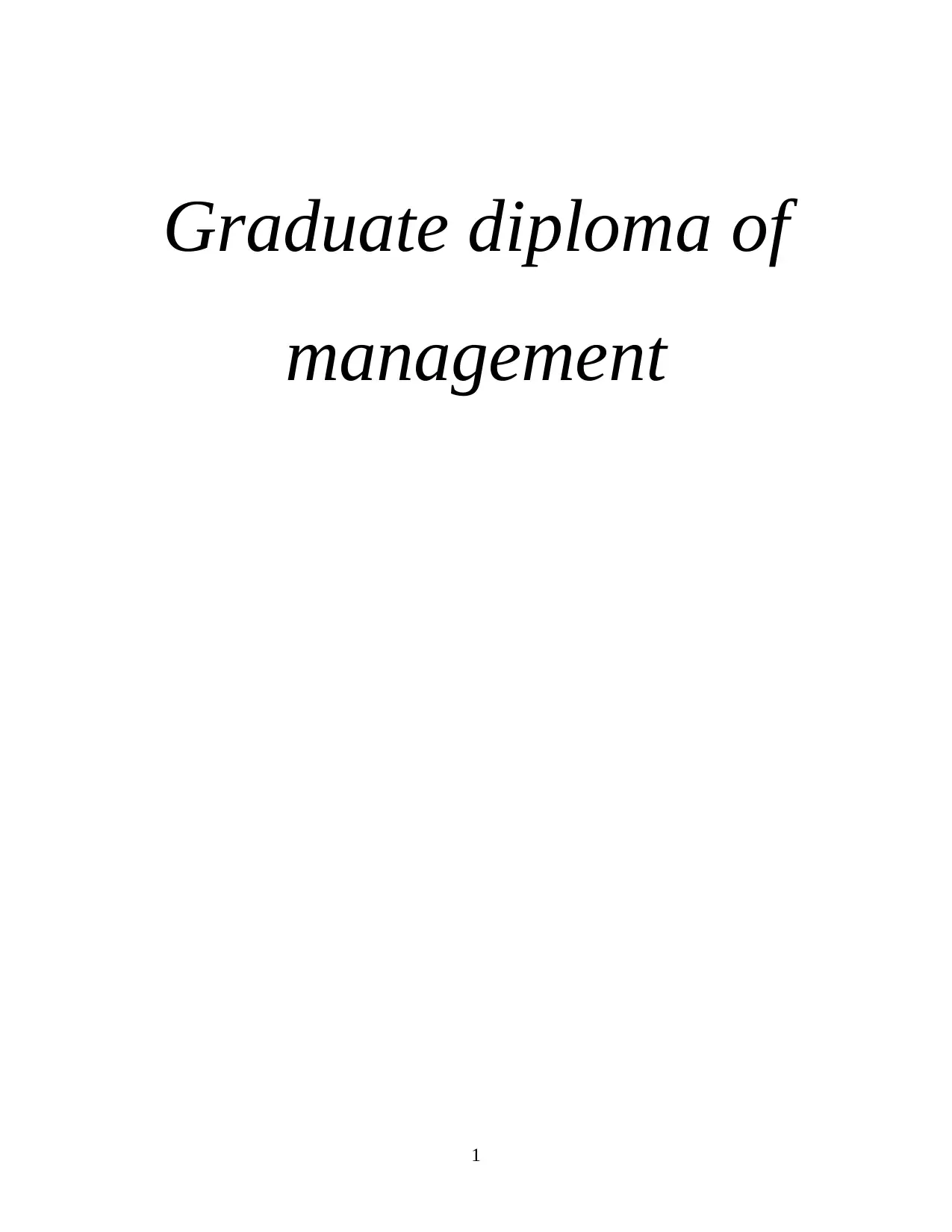
Graduate diploma of
management
1
management
1
Paraphrase This Document
Need a fresh take? Get an instant paraphrase of this document with our AI Paraphraser
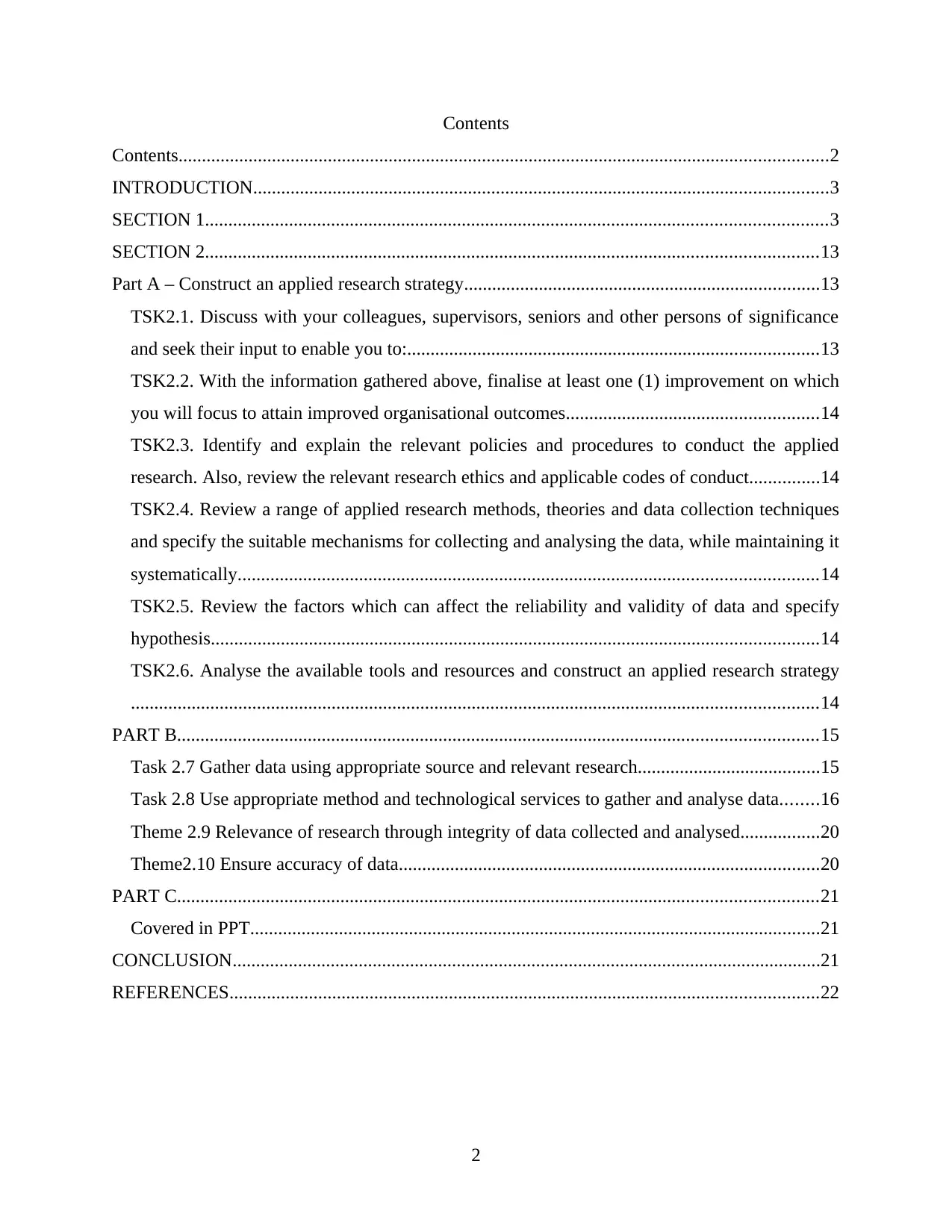
Contents
Contents...........................................................................................................................................2
INTRODUCTION...........................................................................................................................3
SECTION 1.....................................................................................................................................3
SECTION 2...................................................................................................................................13
Part A – Construct an applied research strategy............................................................................13
TSK2.1. Discuss with your colleagues, supervisors, seniors and other persons of significance
and seek their input to enable you to:........................................................................................13
TSK2.2. With the information gathered above, finalise at least one (1) improvement on which
you will focus to attain improved organisational outcomes......................................................14
TSK2.3. Identify and explain the relevant policies and procedures to conduct the applied
research. Also, review the relevant research ethics and applicable codes of conduct...............14
TSK2.4. Review a range of applied research methods, theories and data collection techniques
and specify the suitable mechanisms for collecting and analysing the data, while maintaining it
systematically............................................................................................................................14
TSK2.5. Review the factors which can affect the reliability and validity of data and specify
hypothesis..................................................................................................................................14
TSK2.6. Analyse the available tools and resources and construct an applied research strategy
...................................................................................................................................................14
PART B.........................................................................................................................................15
Task 2.7 Gather data using appropriate source and relevant research.......................................15
Task 2.8 Use appropriate method and technological services to gather and analyse data........16
Theme 2.9 Relevance of research through integrity of data collected and analysed.................20
Theme2.10 Ensure accuracy of data..........................................................................................20
PART C.........................................................................................................................................21
Covered in PPT..........................................................................................................................21
CONCLUSION..............................................................................................................................21
REFERENCES..............................................................................................................................22
2
Contents...........................................................................................................................................2
INTRODUCTION...........................................................................................................................3
SECTION 1.....................................................................................................................................3
SECTION 2...................................................................................................................................13
Part A – Construct an applied research strategy............................................................................13
TSK2.1. Discuss with your colleagues, supervisors, seniors and other persons of significance
and seek their input to enable you to:........................................................................................13
TSK2.2. With the information gathered above, finalise at least one (1) improvement on which
you will focus to attain improved organisational outcomes......................................................14
TSK2.3. Identify and explain the relevant policies and procedures to conduct the applied
research. Also, review the relevant research ethics and applicable codes of conduct...............14
TSK2.4. Review a range of applied research methods, theories and data collection techniques
and specify the suitable mechanisms for collecting and analysing the data, while maintaining it
systematically............................................................................................................................14
TSK2.5. Review the factors which can affect the reliability and validity of data and specify
hypothesis..................................................................................................................................14
TSK2.6. Analyse the available tools and resources and construct an applied research strategy
...................................................................................................................................................14
PART B.........................................................................................................................................15
Task 2.7 Gather data using appropriate source and relevant research.......................................15
Task 2.8 Use appropriate method and technological services to gather and analyse data........16
Theme 2.9 Relevance of research through integrity of data collected and analysed.................20
Theme2.10 Ensure accuracy of data..........................................................................................20
PART C.........................................................................................................................................21
Covered in PPT..........................................................................................................................21
CONCLUSION..............................................................................................................................21
REFERENCES..............................................................................................................................22
2
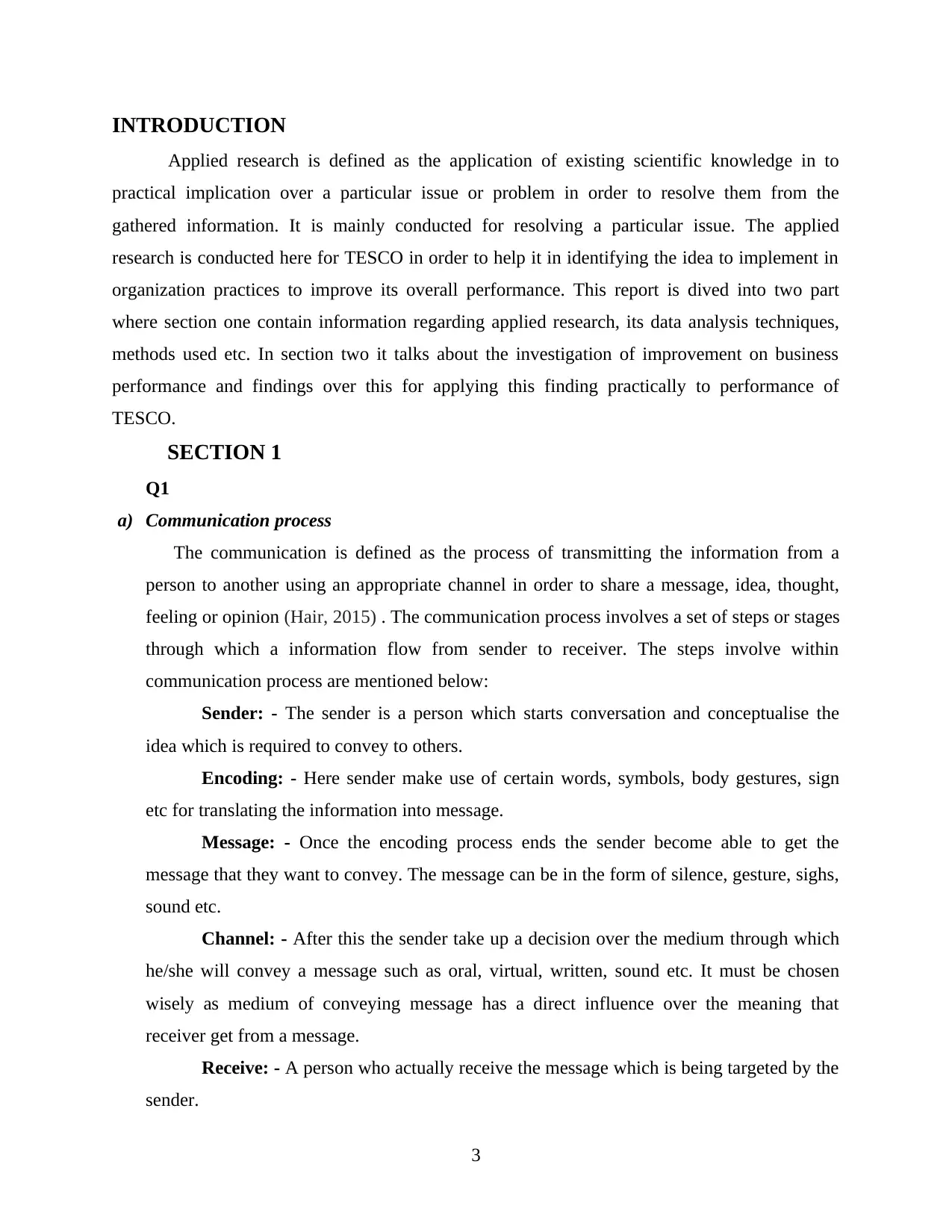
INTRODUCTION
Applied research is defined as the application of existing scientific knowledge in to
practical implication over a particular issue or problem in order to resolve them from the
gathered information. It is mainly conducted for resolving a particular issue. The applied
research is conducted here for TESCO in order to help it in identifying the idea to implement in
organization practices to improve its overall performance. This report is dived into two part
where section one contain information regarding applied research, its data analysis techniques,
methods used etc. In section two it talks about the investigation of improvement on business
performance and findings over this for applying this finding practically to performance of
TESCO.
SECTION 1
Q1
a) Communication process
The communication is defined as the process of transmitting the information from a
person to another using an appropriate channel in order to share a message, idea, thought,
feeling or opinion (Hair, 2015) . The communication process involves a set of steps or stages
through which a information flow from sender to receiver. The steps involve within
communication process are mentioned below:
Sender: - The sender is a person which starts conversation and conceptualise the
idea which is required to convey to others.
Encoding: - Here sender make use of certain words, symbols, body gestures, sign
etc for translating the information into message.
Message: - Once the encoding process ends the sender become able to get the
message that they want to convey. The message can be in the form of silence, gesture, sighs,
sound etc.
Channel: - After this the sender take up a decision over the medium through which
he/she will convey a message such as oral, virtual, written, sound etc. It must be chosen
wisely as medium of conveying message has a direct influence over the meaning that
receiver get from a message.
Receive: - A person who actually receive the message which is being targeted by the
sender.
3
Applied research is defined as the application of existing scientific knowledge in to
practical implication over a particular issue or problem in order to resolve them from the
gathered information. It is mainly conducted for resolving a particular issue. The applied
research is conducted here for TESCO in order to help it in identifying the idea to implement in
organization practices to improve its overall performance. This report is dived into two part
where section one contain information regarding applied research, its data analysis techniques,
methods used etc. In section two it talks about the investigation of improvement on business
performance and findings over this for applying this finding practically to performance of
TESCO.
SECTION 1
Q1
a) Communication process
The communication is defined as the process of transmitting the information from a
person to another using an appropriate channel in order to share a message, idea, thought,
feeling or opinion (Hair, 2015) . The communication process involves a set of steps or stages
through which a information flow from sender to receiver. The steps involve within
communication process are mentioned below:
Sender: - The sender is a person which starts conversation and conceptualise the
idea which is required to convey to others.
Encoding: - Here sender make use of certain words, symbols, body gestures, sign
etc for translating the information into message.
Message: - Once the encoding process ends the sender become able to get the
message that they want to convey. The message can be in the form of silence, gesture, sighs,
sound etc.
Channel: - After this the sender take up a decision over the medium through which
he/she will convey a message such as oral, virtual, written, sound etc. It must be chosen
wisely as medium of conveying message has a direct influence over the meaning that
receiver get from a message.
Receive: - A person who actually receive the message which is being targeted by the
sender.
3
⊘ This is a preview!⊘
Do you want full access?
Subscribe today to unlock all pages.

Trusted by 1+ million students worldwide
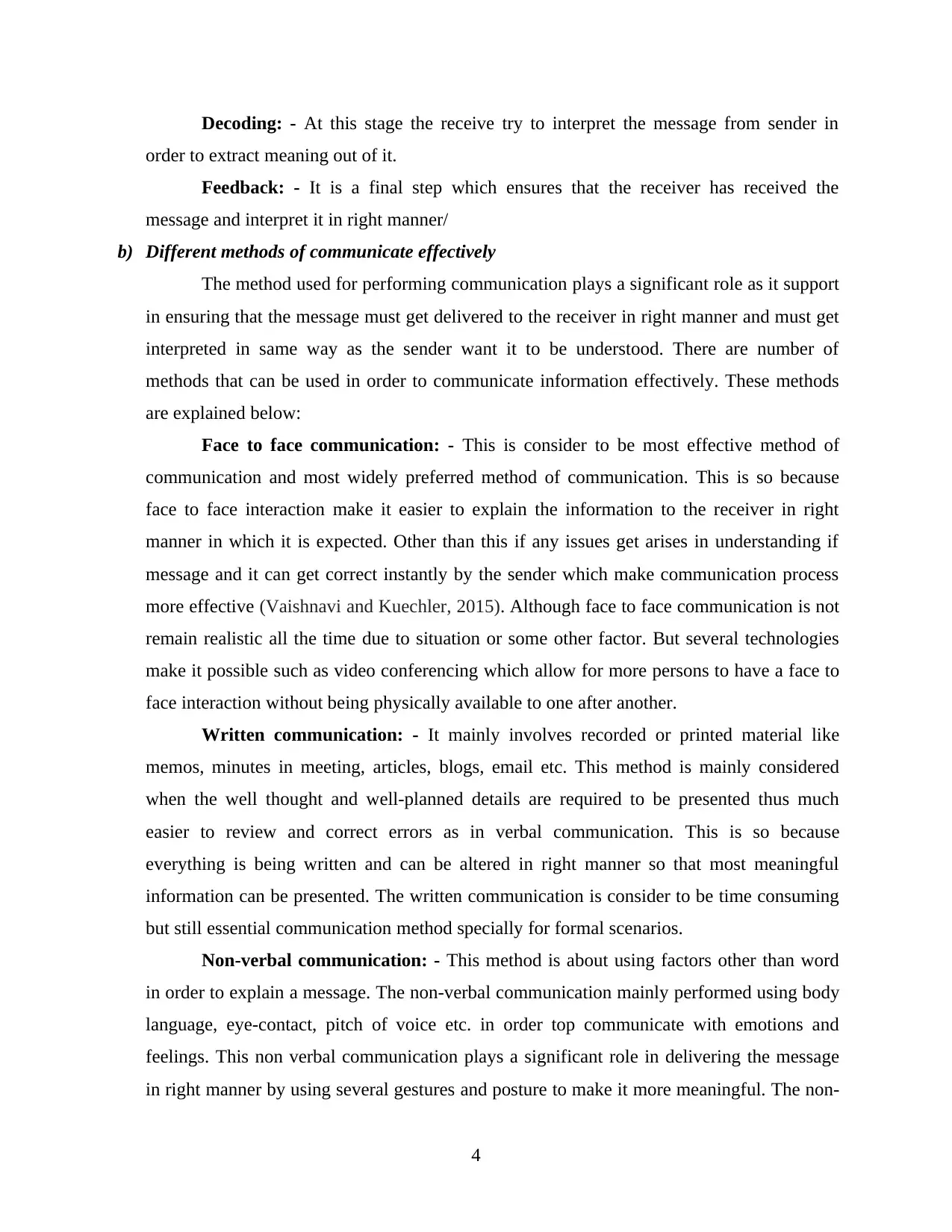
Decoding: - At this stage the receive try to interpret the message from sender in
order to extract meaning out of it.
Feedback: - It is a final step which ensures that the receiver has received the
message and interpret it in right manner/
b) Different methods of communicate effectively
The method used for performing communication plays a significant role as it support
in ensuring that the message must get delivered to the receiver in right manner and must get
interpreted in same way as the sender want it to be understood. There are number of
methods that can be used in order to communicate information effectively. These methods
are explained below:
Face to face communication: - This is consider to be most effective method of
communication and most widely preferred method of communication. This is so because
face to face interaction make it easier to explain the information to the receiver in right
manner in which it is expected. Other than this if any issues get arises in understanding if
message and it can get correct instantly by the sender which make communication process
more effective (Vaishnavi and Kuechler, 2015). Although face to face communication is not
remain realistic all the time due to situation or some other factor. But several technologies
make it possible such as video conferencing which allow for more persons to have a face to
face interaction without being physically available to one after another.
Written communication: - It mainly involves recorded or printed material like
memos, minutes in meeting, articles, blogs, email etc. This method is mainly considered
when the well thought and well-planned details are required to be presented thus much
easier to review and correct errors as in verbal communication. This is so because
everything is being written and can be altered in right manner so that most meaningful
information can be presented. The written communication is consider to be time consuming
but still essential communication method specially for formal scenarios.
Non-verbal communication: - This method is about using factors other than word
in order to explain a message. The non-verbal communication mainly performed using body
language, eye-contact, pitch of voice etc. in order top communicate with emotions and
feelings. This non verbal communication plays a significant role in delivering the message
in right manner by using several gestures and posture to make it more meaningful. The non-
4
order to extract meaning out of it.
Feedback: - It is a final step which ensures that the receiver has received the
message and interpret it in right manner/
b) Different methods of communicate effectively
The method used for performing communication plays a significant role as it support
in ensuring that the message must get delivered to the receiver in right manner and must get
interpreted in same way as the sender want it to be understood. There are number of
methods that can be used in order to communicate information effectively. These methods
are explained below:
Face to face communication: - This is consider to be most effective method of
communication and most widely preferred method of communication. This is so because
face to face interaction make it easier to explain the information to the receiver in right
manner in which it is expected. Other than this if any issues get arises in understanding if
message and it can get correct instantly by the sender which make communication process
more effective (Vaishnavi and Kuechler, 2015). Although face to face communication is not
remain realistic all the time due to situation or some other factor. But several technologies
make it possible such as video conferencing which allow for more persons to have a face to
face interaction without being physically available to one after another.
Written communication: - It mainly involves recorded or printed material like
memos, minutes in meeting, articles, blogs, email etc. This method is mainly considered
when the well thought and well-planned details are required to be presented thus much
easier to review and correct errors as in verbal communication. This is so because
everything is being written and can be altered in right manner so that most meaningful
information can be presented. The written communication is consider to be time consuming
but still essential communication method specially for formal scenarios.
Non-verbal communication: - This method is about using factors other than word
in order to explain a message. The non-verbal communication mainly performed using body
language, eye-contact, pitch of voice etc. in order top communicate with emotions and
feelings. This non verbal communication plays a significant role in delivering the message
in right manner by using several gestures and posture to make it more meaningful. The non-
4
Paraphrase This Document
Need a fresh take? Get an instant paraphrase of this document with our AI Paraphraser
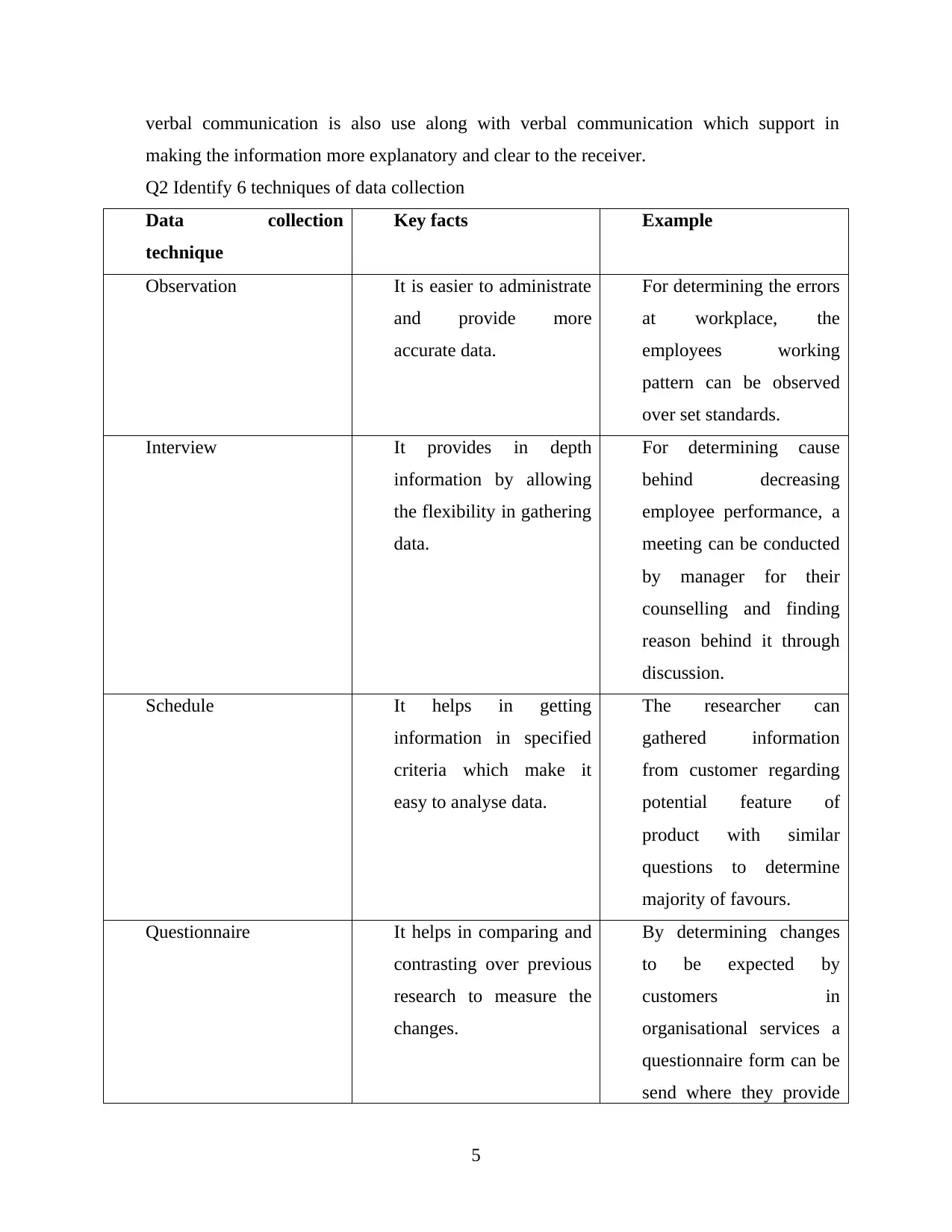
verbal communication is also use along with verbal communication which support in
making the information more explanatory and clear to the receiver.
Q2 Identify 6 techniques of data collection
Data collection
technique
Key facts Example
Observation It is easier to administrate
and provide more
accurate data.
For determining the errors
at workplace, the
employees working
pattern can be observed
over set standards.
Interview It provides in depth
information by allowing
the flexibility in gathering
data.
For determining cause
behind decreasing
employee performance, a
meeting can be conducted
by manager for their
counselling and finding
reason behind it through
discussion.
Schedule It helps in getting
information in specified
criteria which make it
easy to analyse data.
The researcher can
gathered information
from customer regarding
potential feature of
product with similar
questions to determine
majority of favours.
Questionnaire It helps in comparing and
contrasting over previous
research to measure the
changes.
By determining changes
to be expected by
customers in
organisational services a
questionnaire form can be
send where they provide
5
making the information more explanatory and clear to the receiver.
Q2 Identify 6 techniques of data collection
Data collection
technique
Key facts Example
Observation It is easier to administrate
and provide more
accurate data.
For determining the errors
at workplace, the
employees working
pattern can be observed
over set standards.
Interview It provides in depth
information by allowing
the flexibility in gathering
data.
For determining cause
behind decreasing
employee performance, a
meeting can be conducted
by manager for their
counselling and finding
reason behind it through
discussion.
Schedule It helps in getting
information in specified
criteria which make it
easy to analyse data.
The researcher can
gathered information
from customer regarding
potential feature of
product with similar
questions to determine
majority of favours.
Questionnaire It helps in comparing and
contrasting over previous
research to measure the
changes.
By determining changes
to be expected by
customers in
organisational services a
questionnaire form can be
send where they provide
5
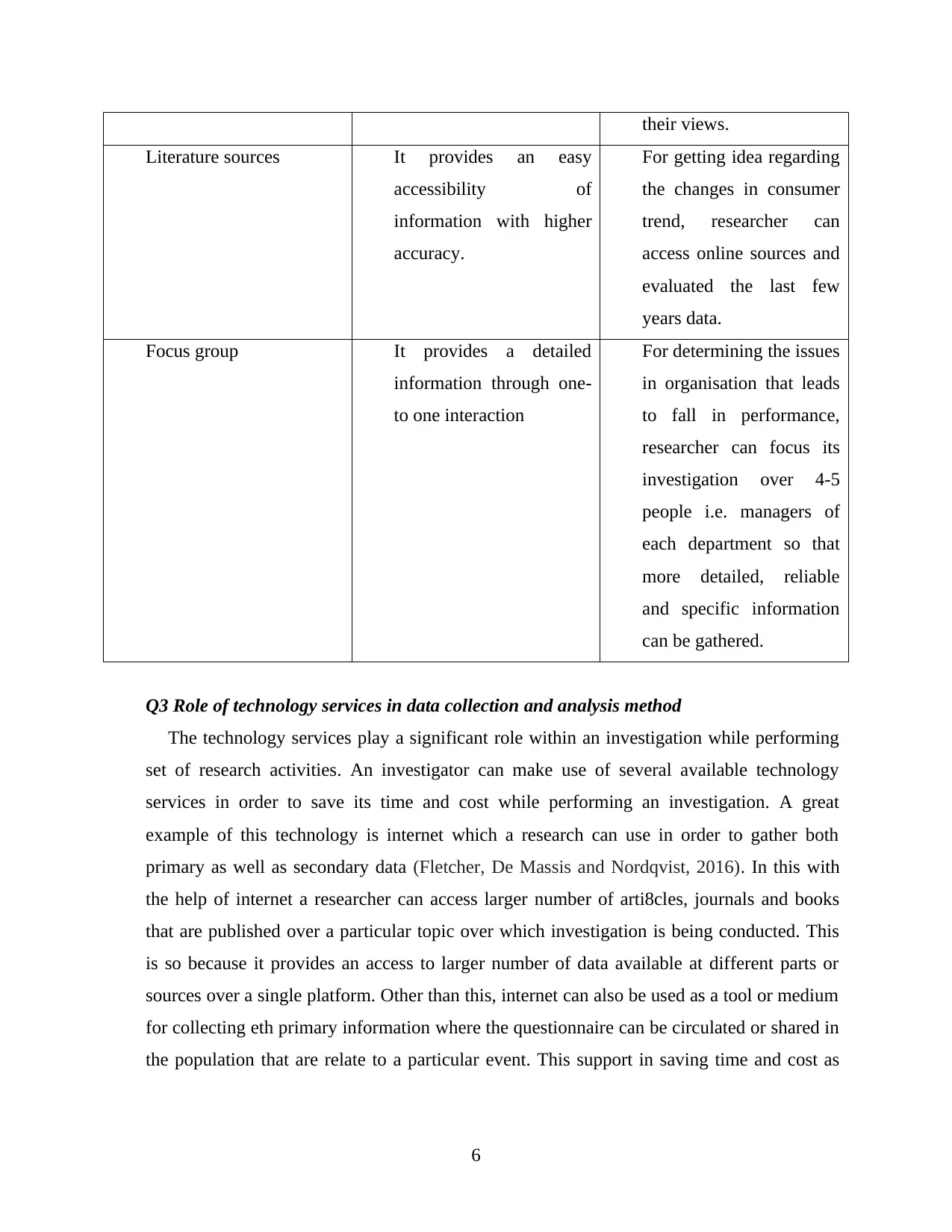
their views.
Literature sources It provides an easy
accessibility of
information with higher
accuracy.
For getting idea regarding
the changes in consumer
trend, researcher can
access online sources and
evaluated the last few
years data.
Focus group It provides a detailed
information through one-
to one interaction
For determining the issues
in organisation that leads
to fall in performance,
researcher can focus its
investigation over 4-5
people i.e. managers of
each department so that
more detailed, reliable
and specific information
can be gathered.
Q3 Role of technology services in data collection and analysis method
The technology services play a significant role within an investigation while performing
set of research activities. An investigator can make use of several available technology
services in order to save its time and cost while performing an investigation. A great
example of this technology is internet which a research can use in order to gather both
primary as well as secondary data (Fletcher, De Massis and Nordqvist, 2016). In this with
the help of internet a researcher can access larger number of arti8cles, journals and books
that are published over a particular topic over which investigation is being conducted. This
is so because it provides an access to larger number of data available at different parts or
sources over a single platform. Other than this, internet can also be used as a tool or medium
for collecting eth primary information where the questionnaire can be circulated or shared in
the population that are relate to a particular event. This support in saving time and cost as
6
Literature sources It provides an easy
accessibility of
information with higher
accuracy.
For getting idea regarding
the changes in consumer
trend, researcher can
access online sources and
evaluated the last few
years data.
Focus group It provides a detailed
information through one-
to one interaction
For determining the issues
in organisation that leads
to fall in performance,
researcher can focus its
investigation over 4-5
people i.e. managers of
each department so that
more detailed, reliable
and specific information
can be gathered.
Q3 Role of technology services in data collection and analysis method
The technology services play a significant role within an investigation while performing
set of research activities. An investigator can make use of several available technology
services in order to save its time and cost while performing an investigation. A great
example of this technology is internet which a research can use in order to gather both
primary as well as secondary data (Fletcher, De Massis and Nordqvist, 2016). In this with
the help of internet a researcher can access larger number of arti8cles, journals and books
that are published over a particular topic over which investigation is being conducted. This
is so because it provides an access to larger number of data available at different parts or
sources over a single platform. Other than this, internet can also be used as a tool or medium
for collecting eth primary information where the questionnaire can be circulated or shared in
the population that are relate to a particular event. This support in saving time and cost as
6
⊘ This is a preview!⊘
Do you want full access?
Subscribe today to unlock all pages.

Trusted by 1+ million students worldwide
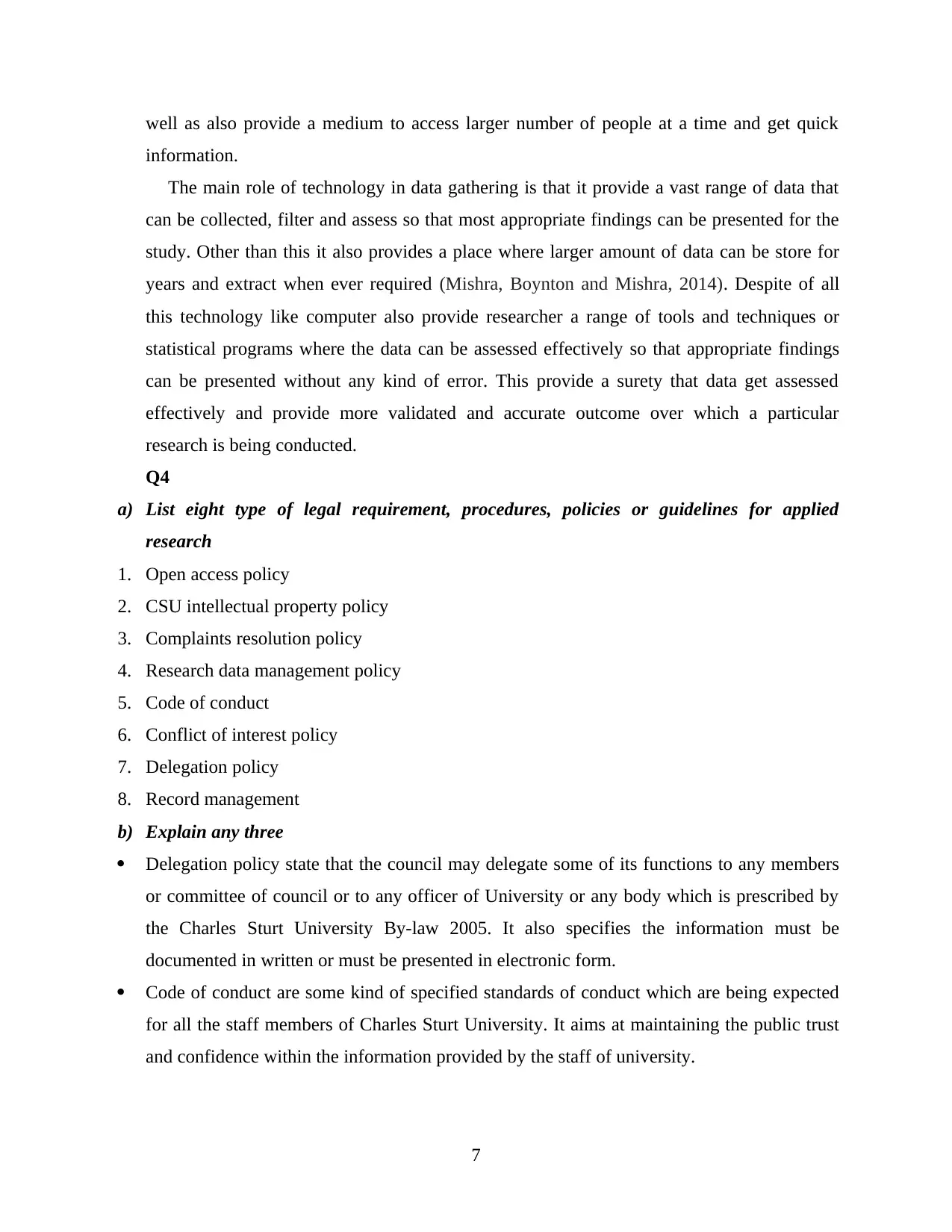
well as also provide a medium to access larger number of people at a time and get quick
information.
The main role of technology in data gathering is that it provide a vast range of data that
can be collected, filter and assess so that most appropriate findings can be presented for the
study. Other than this it also provides a place where larger amount of data can be store for
years and extract when ever required (Mishra, Boynton and Mishra, 2014). Despite of all
this technology like computer also provide researcher a range of tools and techniques or
statistical programs where the data can be assessed effectively so that appropriate findings
can be presented without any kind of error. This provide a surety that data get assessed
effectively and provide more validated and accurate outcome over which a particular
research is being conducted.
Q4
a) List eight type of legal requirement, procedures, policies or guidelines for applied
research
1. Open access policy
2. CSU intellectual property policy
3. Complaints resolution policy
4. Research data management policy
5. Code of conduct
6. Conflict of interest policy
7. Delegation policy
8. Record management
b) Explain any three
Delegation policy state that the council may delegate some of its functions to any members
or committee of council or to any officer of University or any body which is prescribed by
the Charles Sturt University By-law 2005. It also specifies the information must be
documented in written or must be presented in electronic form.
Code of conduct are some kind of specified standards of conduct which are being expected
for all the staff members of Charles Sturt University. It aims at maintaining the public trust
and confidence within the information provided by the staff of university.
7
information.
The main role of technology in data gathering is that it provide a vast range of data that
can be collected, filter and assess so that most appropriate findings can be presented for the
study. Other than this it also provides a place where larger amount of data can be store for
years and extract when ever required (Mishra, Boynton and Mishra, 2014). Despite of all
this technology like computer also provide researcher a range of tools and techniques or
statistical programs where the data can be assessed effectively so that appropriate findings
can be presented without any kind of error. This provide a surety that data get assessed
effectively and provide more validated and accurate outcome over which a particular
research is being conducted.
Q4
a) List eight type of legal requirement, procedures, policies or guidelines for applied
research
1. Open access policy
2. CSU intellectual property policy
3. Complaints resolution policy
4. Research data management policy
5. Code of conduct
6. Conflict of interest policy
7. Delegation policy
8. Record management
b) Explain any three
Delegation policy state that the council may delegate some of its functions to any members
or committee of council or to any officer of University or any body which is prescribed by
the Charles Sturt University By-law 2005. It also specifies the information must be
documented in written or must be presented in electronic form.
Code of conduct are some kind of specified standards of conduct which are being expected
for all the staff members of Charles Sturt University. It aims at maintaining the public trust
and confidence within the information provided by the staff of university.
7
Paraphrase This Document
Need a fresh take? Get an instant paraphrase of this document with our AI Paraphraser
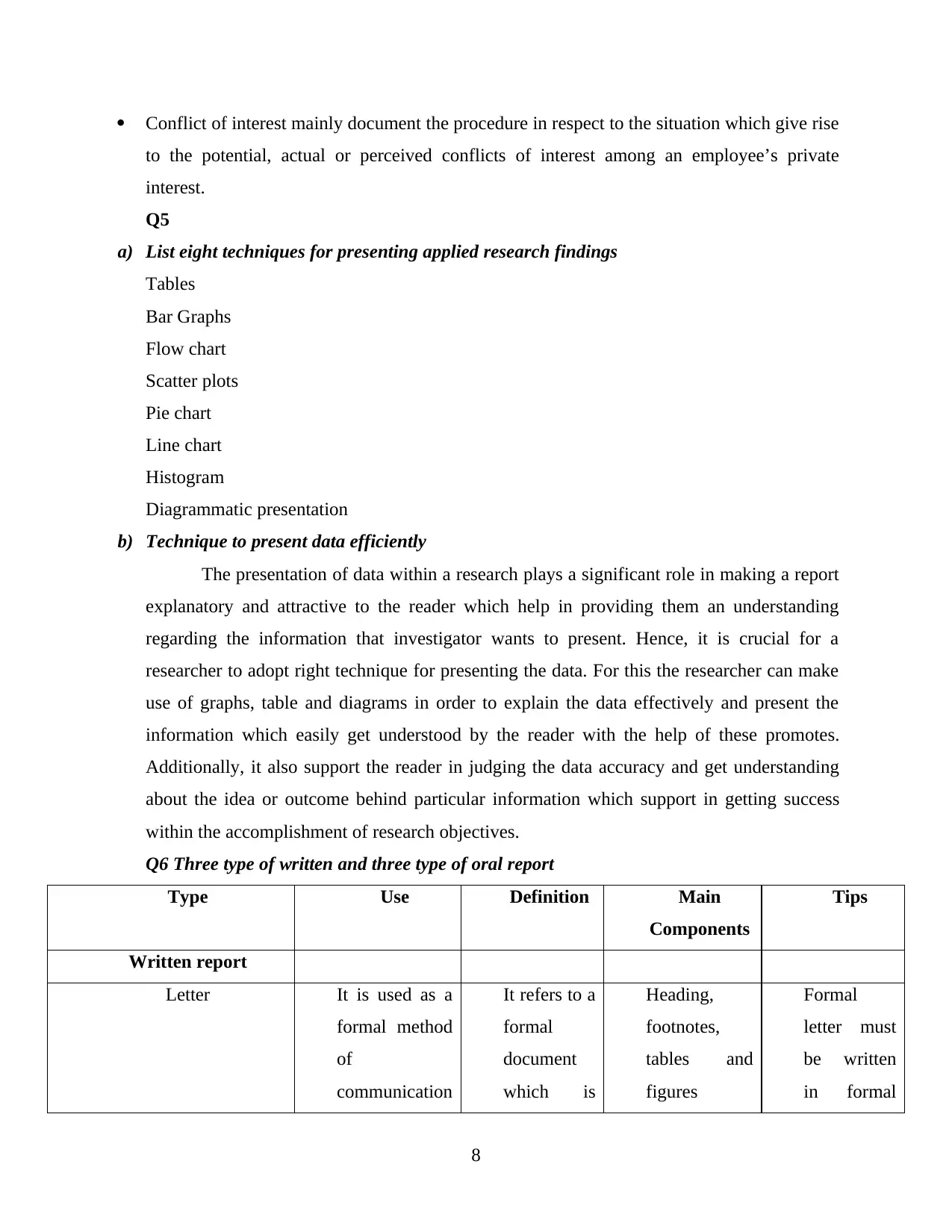
Conflict of interest mainly document the procedure in respect to the situation which give rise
to the potential, actual or perceived conflicts of interest among an employee’s private
interest.
Q5
a) List eight techniques for presenting applied research findings
Tables
Bar Graphs
Flow chart
Scatter plots
Pie chart
Line chart
Histogram
Diagrammatic presentation
b) Technique to present data efficiently
The presentation of data within a research plays a significant role in making a report
explanatory and attractive to the reader which help in providing them an understanding
regarding the information that investigator wants to present. Hence, it is crucial for a
researcher to adopt right technique for presenting the data. For this the researcher can make
use of graphs, table and diagrams in order to explain the data effectively and present the
information which easily get understood by the reader with the help of these promotes.
Additionally, it also support the reader in judging the data accuracy and get understanding
about the idea or outcome behind particular information which support in getting success
within the accomplishment of research objectives.
Q6 Three type of written and three type of oral report
Type Use Definition Main
Components
Tips
Written report
Letter It is used as a
formal method
of
communication
It refers to a
formal
document
which is
Heading,
footnotes,
tables and
figures
Formal
letter must
be written
in formal
8
to the potential, actual or perceived conflicts of interest among an employee’s private
interest.
Q5
a) List eight techniques for presenting applied research findings
Tables
Bar Graphs
Flow chart
Scatter plots
Pie chart
Line chart
Histogram
Diagrammatic presentation
b) Technique to present data efficiently
The presentation of data within a research plays a significant role in making a report
explanatory and attractive to the reader which help in providing them an understanding
regarding the information that investigator wants to present. Hence, it is crucial for a
researcher to adopt right technique for presenting the data. For this the researcher can make
use of graphs, table and diagrams in order to explain the data effectively and present the
information which easily get understood by the reader with the help of these promotes.
Additionally, it also support the reader in judging the data accuracy and get understanding
about the idea or outcome behind particular information which support in getting success
within the accomplishment of research objectives.
Q6 Three type of written and three type of oral report
Type Use Definition Main
Components
Tips
Written report
Letter It is used as a
formal method
of
communication
It refers to a
formal
document
which is
Heading,
footnotes,
tables and
figures
Formal
letter must
be written
in formal
8
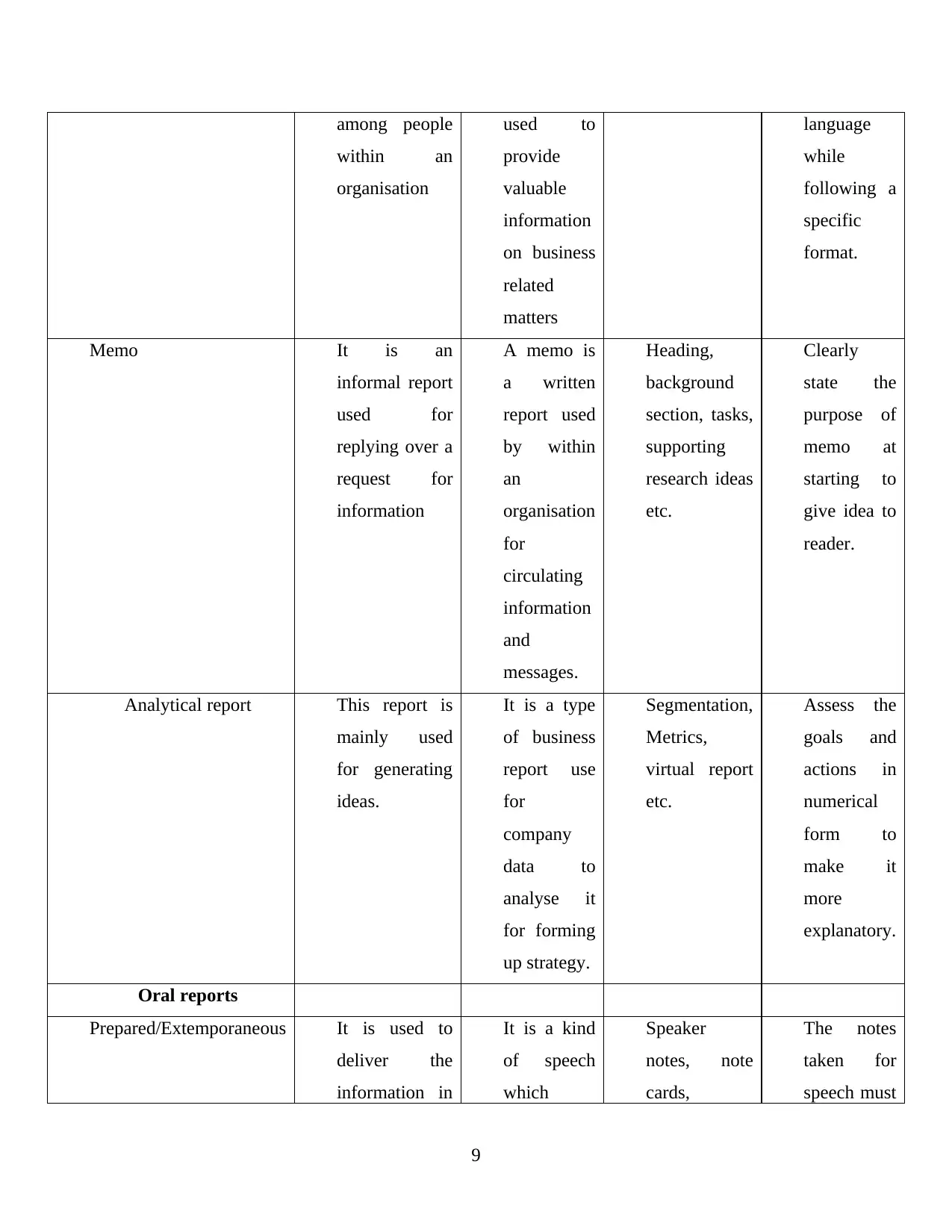
among people
within an
organisation
used to
provide
valuable
information
on business
related
matters
language
while
following a
specific
format.
Memo It is an
informal report
used for
replying over a
request for
information
A memo is
a written
report used
by within
an
organisation
for
circulating
information
and
messages.
Heading,
background
section, tasks,
supporting
research ideas
etc.
Clearly
state the
purpose of
memo at
starting to
give idea to
reader.
Analytical report This report is
mainly used
for generating
ideas.
It is a type
of business
report use
for
company
data to
analyse it
for forming
up strategy.
Segmentation,
Metrics,
virtual report
etc.
Assess the
goals and
actions in
numerical
form to
make it
more
explanatory.
Oral reports
Prepared/Extemporaneous It is used to
deliver the
information in
It is a kind
of speech
which
Speaker
notes, note
cards,
The notes
taken for
speech must
9
within an
organisation
used to
provide
valuable
information
on business
related
matters
language
while
following a
specific
format.
Memo It is an
informal report
used for
replying over a
request for
information
A memo is
a written
report used
by within
an
organisation
for
circulating
information
and
messages.
Heading,
background
section, tasks,
supporting
research ideas
etc.
Clearly
state the
purpose of
memo at
starting to
give idea to
reader.
Analytical report This report is
mainly used
for generating
ideas.
It is a type
of business
report use
for
company
data to
analyse it
for forming
up strategy.
Segmentation,
Metrics,
virtual report
etc.
Assess the
goals and
actions in
numerical
form to
make it
more
explanatory.
Oral reports
Prepared/Extemporaneous It is used to
deliver the
information in
It is a kind
of speech
which
Speaker
notes, note
cards,
The notes
taken for
speech must
9
⊘ This is a preview!⊘
Do you want full access?
Subscribe today to unlock all pages.

Trusted by 1+ million students worldwide
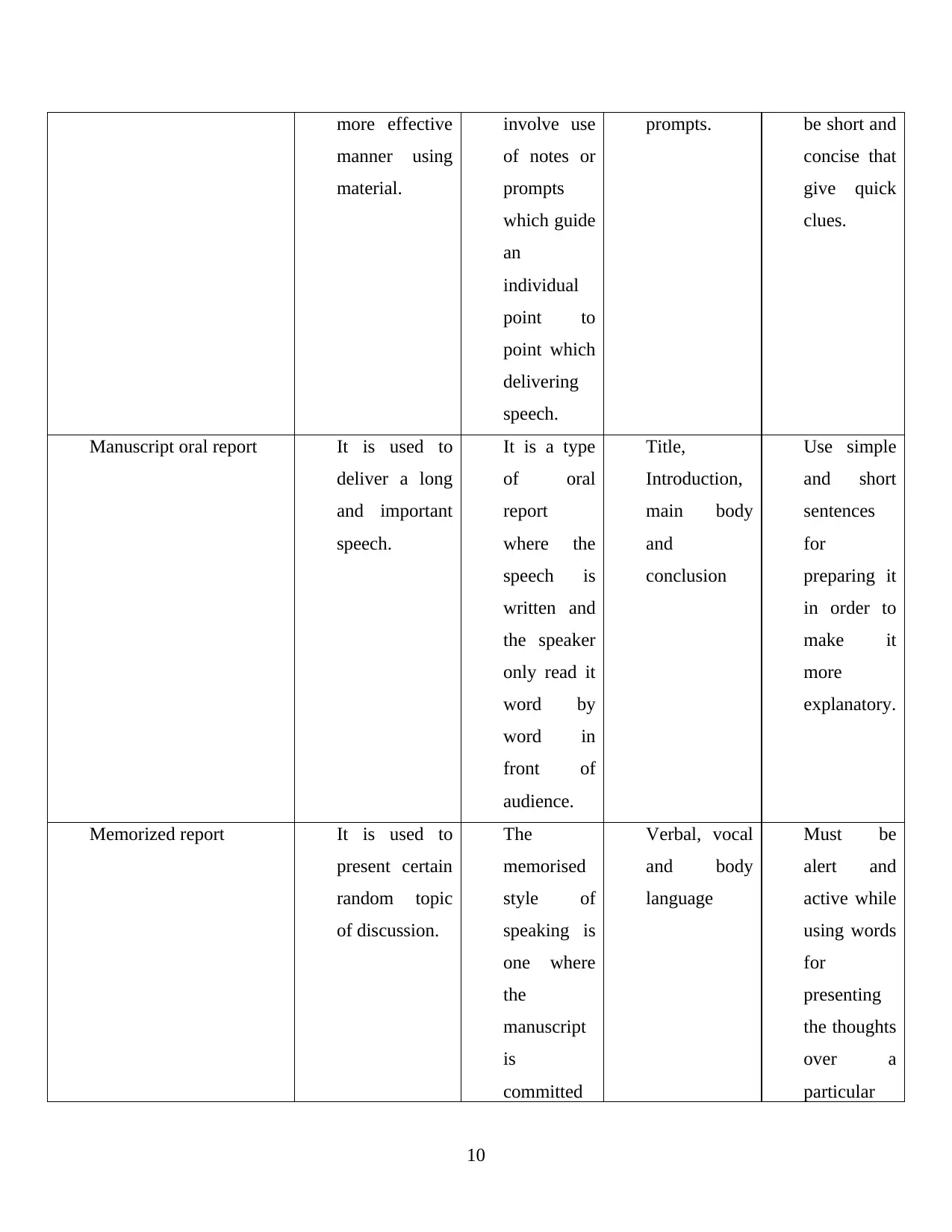
more effective
manner using
material.
involve use
of notes or
prompts
which guide
an
individual
point to
point which
delivering
speech.
prompts. be short and
concise that
give quick
clues.
Manuscript oral report It is used to
deliver a long
and important
speech.
It is a type
of oral
report
where the
speech is
written and
the speaker
only read it
word by
word in
front of
audience.
Title,
Introduction,
main body
and
conclusion
Use simple
and short
sentences
for
preparing it
in order to
make it
more
explanatory.
Memorized report It is used to
present certain
random topic
of discussion.
The
memorised
style of
speaking is
one where
the
manuscript
is
committed
Verbal, vocal
and body
language
Must be
alert and
active while
using words
for
presenting
the thoughts
over a
particular
10
manner using
material.
involve use
of notes or
prompts
which guide
an
individual
point to
point which
delivering
speech.
prompts. be short and
concise that
give quick
clues.
Manuscript oral report It is used to
deliver a long
and important
speech.
It is a type
of oral
report
where the
speech is
written and
the speaker
only read it
word by
word in
front of
audience.
Title,
Introduction,
main body
and
conclusion
Use simple
and short
sentences
for
preparing it
in order to
make it
more
explanatory.
Memorized report It is used to
present certain
random topic
of discussion.
The
memorised
style of
speaking is
one where
the
manuscript
is
committed
Verbal, vocal
and body
language
Must be
alert and
active while
using words
for
presenting
the thoughts
over a
particular
10
Paraphrase This Document
Need a fresh take? Get an instant paraphrase of this document with our AI Paraphraser
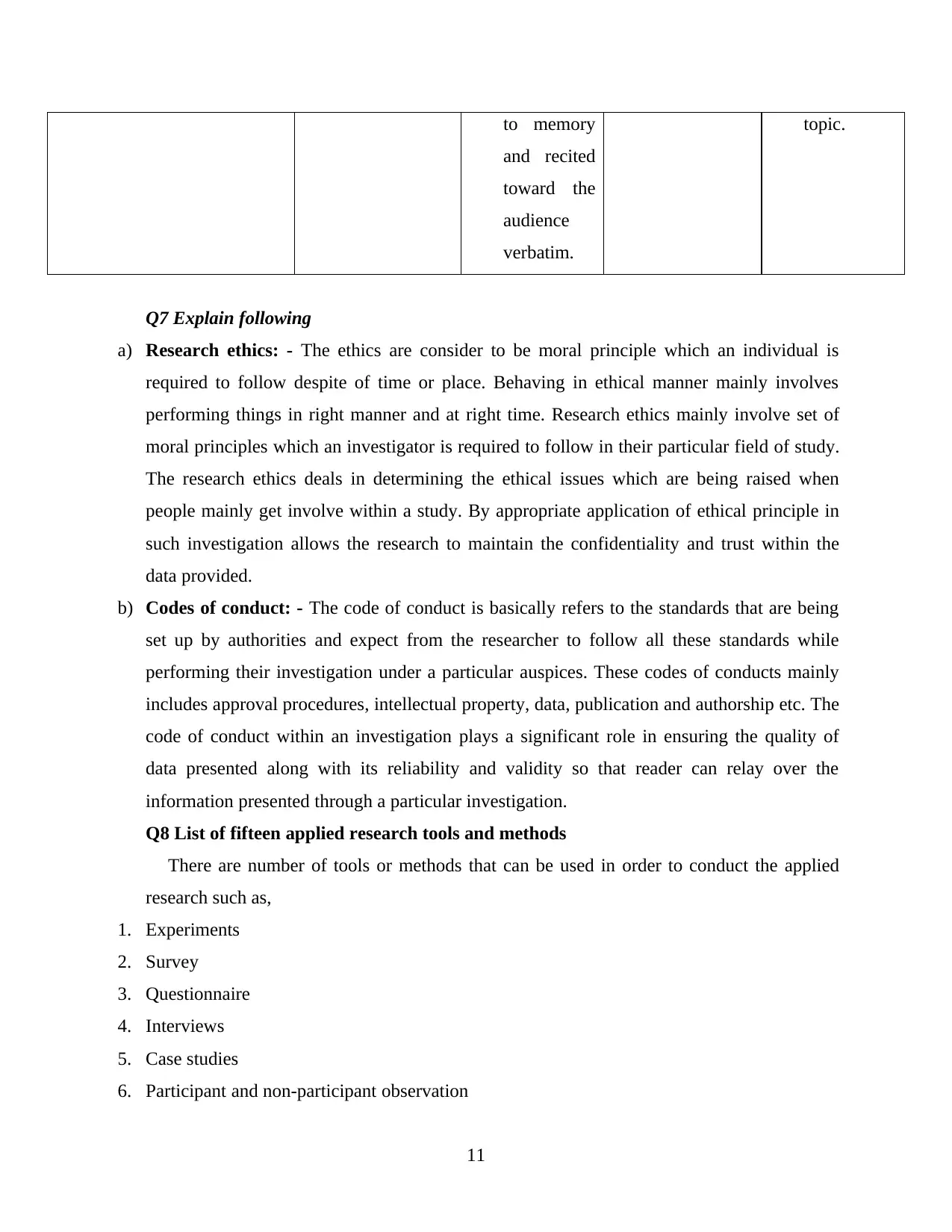
to memory
and recited
toward the
audience
verbatim.
topic.
Q7 Explain following
a) Research ethics: - The ethics are consider to be moral principle which an individual is
required to follow despite of time or place. Behaving in ethical manner mainly involves
performing things in right manner and at right time. Research ethics mainly involve set of
moral principles which an investigator is required to follow in their particular field of study.
The research ethics deals in determining the ethical issues which are being raised when
people mainly get involve within a study. By appropriate application of ethical principle in
such investigation allows the research to maintain the confidentiality and trust within the
data provided.
b) Codes of conduct: - The code of conduct is basically refers to the standards that are being
set up by authorities and expect from the researcher to follow all these standards while
performing their investigation under a particular auspices. These codes of conducts mainly
includes approval procedures, intellectual property, data, publication and authorship etc. The
code of conduct within an investigation plays a significant role in ensuring the quality of
data presented along with its reliability and validity so that reader can relay over the
information presented through a particular investigation.
Q8 List of fifteen applied research tools and methods
There are number of tools or methods that can be used in order to conduct the applied
research such as,
1. Experiments
2. Survey
3. Questionnaire
4. Interviews
5. Case studies
6. Participant and non-participant observation
11
and recited
toward the
audience
verbatim.
topic.
Q7 Explain following
a) Research ethics: - The ethics are consider to be moral principle which an individual is
required to follow despite of time or place. Behaving in ethical manner mainly involves
performing things in right manner and at right time. Research ethics mainly involve set of
moral principles which an investigator is required to follow in their particular field of study.
The research ethics deals in determining the ethical issues which are being raised when
people mainly get involve within a study. By appropriate application of ethical principle in
such investigation allows the research to maintain the confidentiality and trust within the
data provided.
b) Codes of conduct: - The code of conduct is basically refers to the standards that are being
set up by authorities and expect from the researcher to follow all these standards while
performing their investigation under a particular auspices. These codes of conducts mainly
includes approval procedures, intellectual property, data, publication and authorship etc. The
code of conduct within an investigation plays a significant role in ensuring the quality of
data presented along with its reliability and validity so that reader can relay over the
information presented through a particular investigation.
Q8 List of fifteen applied research tools and methods
There are number of tools or methods that can be used in order to conduct the applied
research such as,
1. Experiments
2. Survey
3. Questionnaire
4. Interviews
5. Case studies
6. Participant and non-participant observation
11
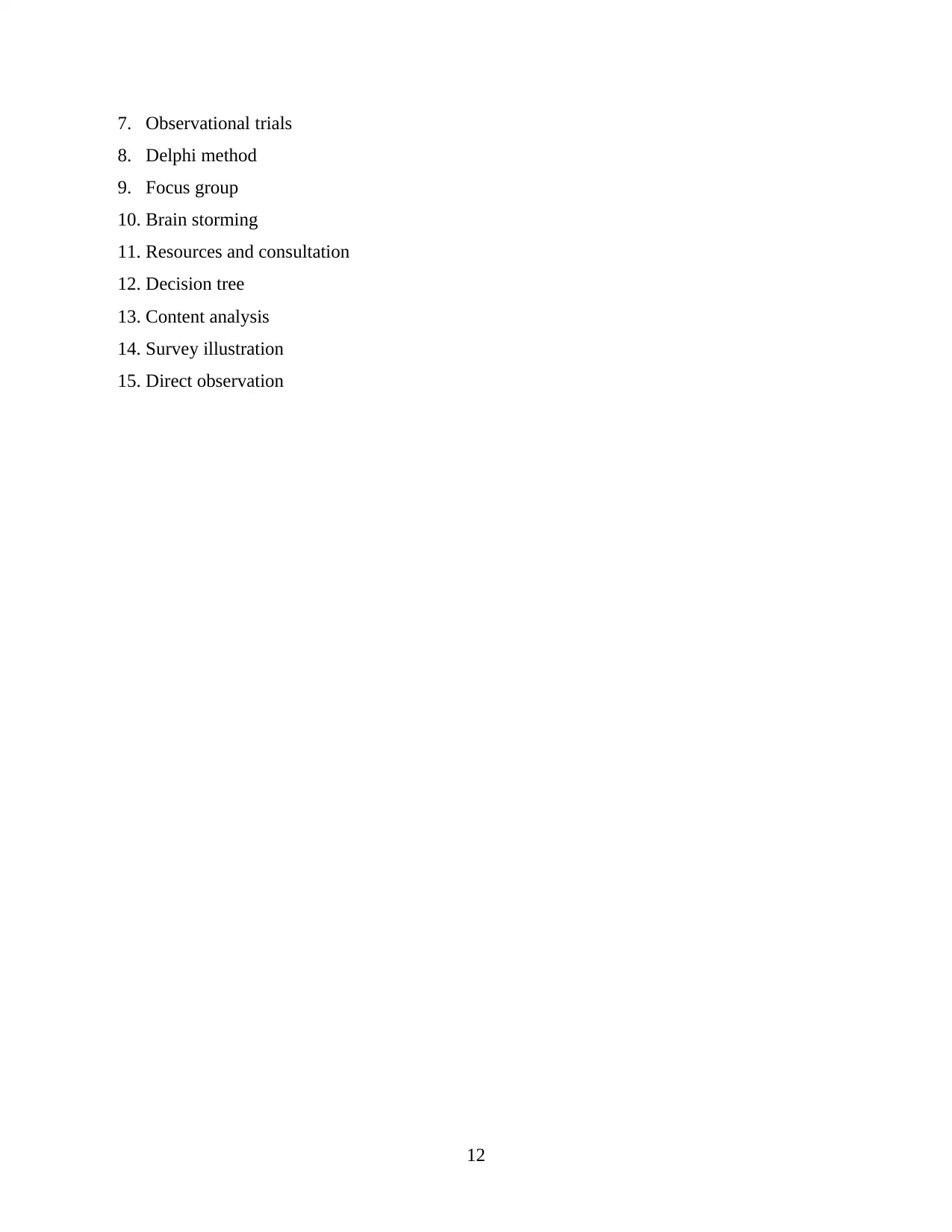
7. Observational trials
8. Delphi method
9. Focus group
10. Brain storming
11. Resources and consultation
12. Decision tree
13. Content analysis
14. Survey illustration
15. Direct observation
12
8. Delphi method
9. Focus group
10. Brain storming
11. Resources and consultation
12. Decision tree
13. Content analysis
14. Survey illustration
15. Direct observation
12
⊘ This is a preview!⊘
Do you want full access?
Subscribe today to unlock all pages.

Trusted by 1+ million students worldwide
1 out of 23
Related Documents
Your All-in-One AI-Powered Toolkit for Academic Success.
+13062052269
info@desklib.com
Available 24*7 on WhatsApp / Email
![[object Object]](/_next/static/media/star-bottom.7253800d.svg)
Unlock your academic potential
Copyright © 2020–2025 A2Z Services. All Rights Reserved. Developed and managed by ZUCOL.





